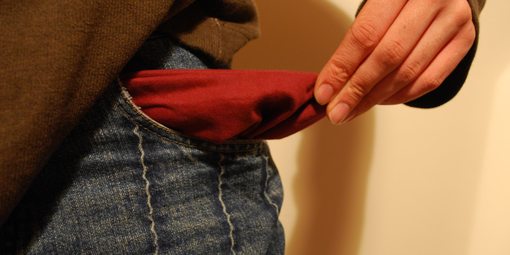5 Questions to Ask for Deciding When to Fire a Client
One of the amazing things about being a freelance designer is the freedom to choose who you are willing to work with. Unlike the nine to five crowd, we freelancers don’t always have bosses or coworkers that we are simply stuck with. If we don’t like working with someone, we fire them and move on.
Though this process sounds dandy in theory, the reality is much more complicated. Like anyone else, we have mortgages, utility bills and an annoyingly expensive need to eat just about every day. If you’ve got a client you can’t stand, run through the questions below to you help decide whether or not you can ditch them successfully (and whether you should).
2 Million+ Digital Assets, With Unlimited Downloads
Get unlimited downloads of 2 million+ design resources, themes, templates, photos, graphics and more. Envato Elements starts at $16 per month, and is the best creative subscription we've ever seen.
Do You Get Along?
This question can seem a bit arbitrary. After all, you’re a professional right? If someone requests your services and is willing to pay, who cares what you think of them on a personal level? However, despite these legitimate objections, the question of whether or not you are compatible with an organization or individual can play a huge role in the stability of a long-term professional relationship.
I know from experience, working with a client that you can’t stand on a daily basis can really start to make an impact on several aspects of your career. You become less satisfied with your job as your enthusiasm for doing what you love begins to wane, the quality of your work declines, and your relationships with other clients suffer.
This is not to say that you need to be best friends with all your clients to love your job. Sorting your clients out by those that occasionally get on your nerves vs. those who don’t will likely land you in a position of virtual unemployment. Ultimately your goal should be to make it work and to get along as best as humanly possible, especially with those that have the potential to provide you with a long-term income stream. However, there will be times when continuing to work with someone will yield more damage than benefits.
Is There Abuse?
This question sounds a bit more serious than is intended. Physical abuse, sexual harassment or something of this nature is definitely serious and obviously worth firing a client over, but most freelancers are probably more likely to experience a different sort of abuse: the abuse of power. This particular brand of abuse comes in many fun flavors, my favorite types of abusive clients are outlined below.
The Ruthless Ruler
When someone hires you to do work for them they either see it as a partnership wherein two parties work together in a mutually beneficial relationship towards a common goal, or a monarchy in which they have ultimate rule over you, the lesser subject and grunt worker. The latter description is of course a bit of an extreme but nevertheless is a very real mindset that countless individuals are forced to endure from their employers and clients.
I have worked for individuals who have outright insulted my work, intelligence and competence as a designer minutes after (or before) hailing something else that I made as incredible. These sort of bipolar ad homonym attacks have absolutely no place in a professional working relationship. Never imagine that anyone, regardless of their authority over you, as any right whatsoever to treat you in such a manner.
In these circumstances, you should clearly define the terms under which you are willing to work. Explain that you are willing to take feedback and make any requested changes granted that the process is rational and reasonable. If the client simply can’t handle acting like a normal human being, do yourself a favor and find a way to drop them completely.
The Deadline Fiend
Often mixed with one of the other types of abusers, the deadline fiend is the guy that calls you with a new project at 5pm on Friday and wants to see something by Sunday morning or sooner (the people I work with call these “out of the blue and suddenly due” projects). I’ve mentioned before that one of the best ways to make your clients see you as valuable is to come through in just such a situation. However, the danger of this is that the client might get used to it and come to expect it from you rather than recognizing how hard you have to work to complete such a task.
If you’re married to your work then working in such a fashion might not be a problem. For anyone else, such a lifestyle begins to take effect quickly. Let your client know that you prefer to have significant lead time on a project (be specific) and consider setting up a fee that will take effect any time they don’t meet your requirement. This allows you to still accept the work and will make your clients think twice about if it is really necessary to have the job completed so soon.
Odds are, you’ll come across a client or two that will be insulted at the imposition of such a fee. Stand your ground and tell them that you are more than willing to accept short deadlines as long as they are willing to understand that such work creates turmoil with other existing projects and therefore must be billed at a higher rate. If they refuse, kindly thank them for the opportunity and decline the work.
The Favor Guy
This is perhaps the trickiest kind of abuse because it is so rarely labeled as such. Every designer quickly realizes that clients, friends, distant relatives, neighbors, and passing strangers are quite prone to think that designers should be more than willing to offer them professional design favors: aka, free work.
Performing such favors is a fine line to walk and exactly where that line should be drawn is different for every designer. I personally am quite prone to perform quick favors for clients at zero cost. It’s a great way to build favor and let them see that you’re a decent human being. However, this tendency has backfired on me more than once. I’ve found myself giving free detailed web design critiques for a client on a daily basis and laying out entire websites for people I don’t even know.
The point is, these types of favors can in fact be an abuse of your professional talent. Some people are nice enough and simply don’t understand how much they’re asking for, others are just looking for a free ride. How you deal with friends and acquaintances is up to you, but my advice is to watch out for clients who seem to get more free work out of you than paid work. These people simply don’t appreciate your profession and should be dropped. After all, if you’re working for free, what’ve you got to lose by canning them?
The Cheapskate
The cheapskate is that one client that you allow to bill you at a much lower rate than everyone else. He or she is always “in a bind” or “needs you to go easy on this one.” The abuse is not that they don’t have big budgets, but that the projects are not proportional to their budgets. It’s fine to tell a designer that you can only spend $300 on a project, but if that project is a complicated, multi-page custom website design and backend coding, you’re pushing your luck.
Be wary of giving certain clients preferential treatment. Working like this can really hold you back in your career and income opportunities. Freelancers are often in a precarious situation of wanting to charge more but being afraid of losing the work altogether if they tried. The first thing you should do is to make sure you don’t overvalue yourself. Look into hiring others with comparable experience and background to see what they’re charging. Then, adjust your rate accordingly and stick to it for a trial period. You might lose some low paying clients but pick up the slack with higher paying jobs.
Do You Enjoy the Work?
One of the most important questions to ask yourself while considering whether or not to fire a client is how much you enjoy the work. Sometimes you can have a great client who pays quite well, but you simply hate the work you’re doing for them. If work is slim and difficult to come by, I would absolutely advise you to suck it up and take the work. That said, doing work that you simply don’t enjoy can really weigh on you.
I’ve done everything from brand design to coupon layout, fortunately I enjoy the challenges presented by most sorts of design and only occasionally come across something that I simply can’t stand. The work that I tend to avoid if possible is the stuff that requires less design and more mindless repetition. Another big pet peeve is when clients always want you to use their approved resources, but provide you with absolutely horrid art. It’s hard to love your job when you’re putting your client’s hideous logo that you didn’t make on their hideous stock photo that you didn’t select along with their lame headline that you didn’t write. Sometimes through no fault of your own, the end product is something that you would be ashamed to admit that you created.
You might be the opposite. Maybe you love the puzzle of trying to make bad resources look good but hate designing from scratch. Whatever it is you love to do, pursue work that will allow you to spend most of your time doing it.
Do You Have Time For the Work?

This question is the one I struggle with the most. I tend to get excited about new opportunities and as a consequence find myself working 15 hour days several times per week. Sometimes the decision of whether or not to fire a client lies solely in the amount of time you can dedicate to that person’s projects. Strangely enough, this situation can turn firing a client into you actually doing them a favor.
Taking on a client means making a commitment to deliver quality, timely work. The less time you have to devote proper attention to a specific client’s projects, the more your quality will suffer as a result. In these circumstances, explain that you simply can’t devote the amount of time their projects deserve. Make it apparent that you ultimately want what’s best for them and that you’ve come to realize they would in fact be better off working with another designer. At this point, if you have friends or professional acquaintances that are also designers, it’s the perfect time to throw out some referrals. Your client won’t feel so much like you’re leaving them high and dry and your friend will appreciate the extra business.
Do You Need the Client?
This last question is the most important of all and might even be the first one you should ask. Depending on the answer, many of the answers to the questions above could become irrelevant. Someone once told me that freelance design is a “feast and famine” business. What this means is that sometimes you’ll have more work than you can handle and at others times you’ll be forced to take whatever you can get. There are two key areas to examine regarding whether or not you need a client:
Money
Obviously, the most pressing factor is often financial. Can you afford to fire this client? Don’t say “yes” too hastily without giving a good long look at what your income will look like without the client in question. Examine both your long term and short term financial goals and decide whether or not you can still meet these goals while eliminating a portion of your work and also whether or not it’s worth it to sacrifice these goals.
If the answer is no, the situation becomes quite difficult but doesn’t mean you should give up. This is where the next factor comes into play.
Replacement Work
Whether or not you can afford to drop a client depends heavily on whether or not you can (or even need to) replace the income the client was providing you. Obviously, if you’ll have no trouble doing so then stop deliberating and ditch the bad client in favor of a better one. However, freelancer designers don’t always have people beating down their door with potential projects. In these circumstances discovering whether or not you can replace the work requires a lot more effort.
My best advice is to not make hasty decisions about dropping clients before you’ve done your homework. Start poking around for extra work to see what comes up before you give serious consideration to firing anyone. Some designers tell themselves it will be a cinch and are dumbfounded when their phone doesn’t start ringing simply because they have declared themselves available for work on their website. Other designers imagine the freelance design market to be a much more brutal place than it really is and will in reality have a much easier time supporting themselves than they might expect.
My point is, you won’t know until you try. It’s always difficult to look for work when you’re too busy actually working, but putting forth the extra effort to see if you can land a few new accounts is completely worth it. Even if you’re fairly satisfied with your clients and current workload, it’s always a good idea to hedge your bets and explore other options.
Final Thoughts
I’ve recently been forces to fire a couple of clients and the process wasn’t fun at all. The questions above brought me no small amount of deliberation and stress but in the end they needed to be asked. My one final piece of advice is to be smart when firing a client. There is often no need to burn bridges and ruin relationships. It is beneficial to both parties to part ways peacefully while keeping open the possibility of working together again in the future. If you can manage it, this is the best possible scenario and can turn the entire process around into a fairly positive experience.






